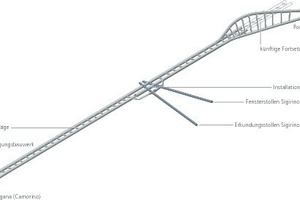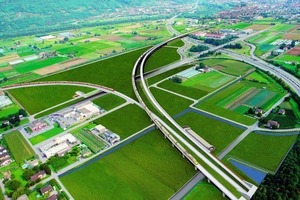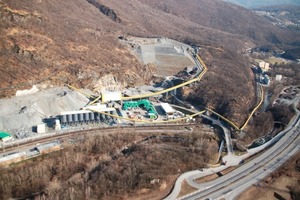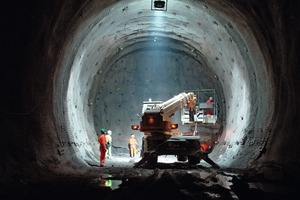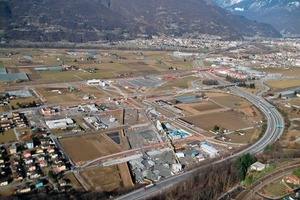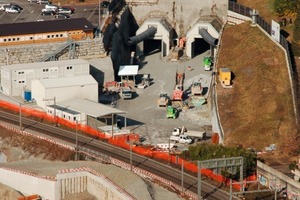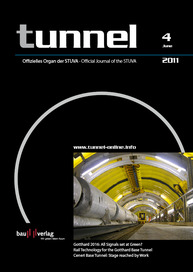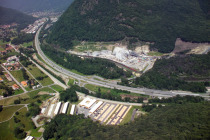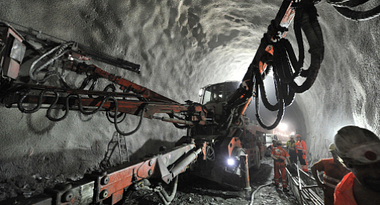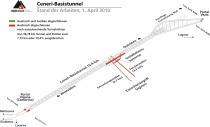Ceneri Base Tunnel: Stage reached by Work
After the Gotthard Base Tunnel and the Lötschberg Base Tunnel, the Ceneri Base Tunnel is the third biggest construction project undertaken by the Swiss Federal Railways. Only thanks to the Ceneri Base Tunnel will the new rail link through the Swiss Alps evolve as a continuous flat trajectory railway (Fig. 1).
1 Introduction
The Ceneri Base Tunnel passes through Monte Ceneri over a length of 15.4 km. The overburdens amount up to 800 m. The route alignment takes the geological and topographical conditions into consideration as well as the population density and the links to the existing SBB lines in Camorino near Bellinzona and Vezia at Lugano.
The tunnel system consists of 2 single-track bores set 40 m apart. This route alignment caters for a future continuation towards the north (crossing through the Magadino plain and bypassing Bellinzona and towards the south. The branch chambers in the south are devised in such a way that it will be possible to construct a future extension of the Ceneri Base Tunnel to Chiasso without interrupting train services for any prolonged length of time. The strict division into 2 single-track bores and the connections to the existing line in the north in both opposing directions Bellinzona and Locarno call for branch chambers in the north portals as well. The link with the main line in the direction of Locarno, the “Bretella”, will permit direct connections from and to Lugano in future without changing at Bellinzona. This will also improve regional train services.
Essential safety aspects for the operational phase have also been taken into account for the Ceneri Base Tunnel. The tunnel bores are connected by cross-passages set 325 m apart. The ventilation centre for emergency ventilation is to be established at Sigirino. There is no need to build a Multi-Function Station as in the case of the Gotthard Base Tunnel on account of the Ceneri Base Tunnel’s length. Thus emergency exits are being planned at the north and south portals. In addition a rail technology building is to be set up close to the portals. This is still at the planning stage.
2 Construction Concept
Planning the construction activities for the Ceneri Base Tunnel had to take the in part shallow overburden, the densely populated areas close to the portals and passing under and over important transport routes into consideration. The latter was the reason why it was decided to drive the tunnel bores mainly from Sigirino in the middle of the tunnel route. From this point the excavation is executed in both directions towards the portals. At the same time counter-drives are undertaken at portals, enabling time and cost optimisation as well as the application of more gentle construction methods at these tricky points. At the north portal the Ceneri Base Tunnel underpasses in soft ground the N2 motorway, which is located at a level only 9 m higher. In the “Nodo di Camorino” a new 4-track bridge crosses the A2 motorway and 2 new single-track viaducts span the 4-lane cantonal road. At the south portal the tunnel bores cross the new Vedeggio-Cassarate road tunnel with only a 4 m gap. Damage and operational delays affecting transport facilities belonging to third parties must be avoided at all costs. The various phases of construction, the construction programme, the chosen construction methods as well as the appropriate planning of measures and monitoring the structure take this into account to a high degree.
Back in the years 1997 till 2000, a 3.1 km long exploratory tunnel was driven via drill+blast at Sigirino to the future tunnel axes. This resulted in invaluable findings on the anticipated geology at the central point of attack being obtained. The stable orthogneisses, which were encountered In Monte Ceneri and other gneisses by and large do not present difficult conditions for building the tunnel. Phylonites, mylonites as well as amphilobite slate and serpentinites can be encountered locally. In particular little water is expected in the tunnel cross-section.
3 Preliminary Work
Just like building any tunnel no tunnelling activities are possible at the Ceneri without an infrastructure. Firstly the installation yards at Camorino, Sigirino and Vezia had to be established and developed. Extensive engineering works and road building activities for traffic were needed especially for the Camorino and Sigirino construction sites. Today both sites are optimally linked up with the cantonal roads and the A2 motorway.
3.1 Camorino
In the vicinity of the north portal numerous foundation engineering operations have been undertaken and infrastructures for the construction site, which extends over 500,000 m², carried out. In the area occupied by the site the 2.7 km long, open newly built route runs from Giubiasco Station accessing the north portal. From the north portal 2 new reinforced concrete viaducts – 1,000 and 400 m long respectively – lead to a new 4-track rail bridge over the A2 motorway. The remainder of the new rail track runs over earth fills. The subsoil is regarded as extremely prone to subsidence. Locally settlements of up to 80 cm have been measured. In order to ensure that these do not occur during construction preloaded fills are employed to reduce settlements (Fig. 2).
3.2 Sigirino
Building the site village was numbered among the first preliminary operations: accommodation for 450 members of staff, a canteen, change-house, 2 office buildings and a building for visitors to the site. As the major portion of the Ceneri Base Tunnel is to be excavated from this point, the material preparation and material storage facilities belong to the most important infrastructural installations. In this connection between 2007 and 2009 the transfer tower in front of the portal of the access tunnel, silos connected to the works track, conveyor belts and the installation for producing the rock aggregates for concrete production were set up. During 2008 and 2009 the material excavated from the access tunnel and the logistics chamber was processed accordingly. The dump for the final storage of the excavated material can hold 7.5 mill. t or 3.5 m³. The material from Vezia and Vigana is also mainly stored in Sigirino. Storage is carried out in such a manner that it fits in optimally with the landscape. By means of suitable greening it becomes part of a game corridor, which is continued with the establishment of the “Dosso di Taverne” wild animal passage. Work on this passage with the transport hub located beneath it was due to begin in March 2011 (Fig. 3).
For driving the tunnel as such it was first of all essential to excavate an access tunnel, which is dimensioned to accommodate the conveyor belt system and site vehicles passing one another. The tunnel is 9.7 m in diameter, 2.3 km long and was produced between the beginning of September 2007 and November 2008. It was decided to excavate with a tunnel boring machine principally for noise abatement reasons to satisfy the municipality of Sigirino. The drive started in March 2008 with the breakthrough into the logistics chamber (Caverna operative CAOP) taking place on November 6, 2008. Today various chambers contain the construction site installations for the main drives; the concrete plant for the inner lining has been operational in the biggest chamber since October 2010. Thanks to the development via the exploratory tunnel it was possible to continue with the excavation work for this system of chambers (7 chambers) parallel to driving the access tunnel. The system of chambers including bypass connections was completed by the main contractor in December 2010.
3.3 Vezia
This is an extremely sophisticated construction site because it is located in a tricky environment and was difficult to develop. The SBB main line is located in the direct vicinity along with the A2 motorway and the construction site for the PTL (Plano dei trasporti del Luganese) road tunnel, which is due to become operational at the end of 2011. During the preparatory phase particular attention had to be paid to the conserved Villa Negroni, which is located immediately above the site. Admittedly the Ceneri Base Tunnel’s south portal was located as far away as possible from the subsidence-prone Villa Negroni. However a precut had to be produced, which lay at a depth of some 25 m beneath the Villa. A retaining wall was produced to close off the excavation pit and monitored with suitable instruments. The soft ground lying on top was first excavated. Then in summer 2009 carefully controlled blasts with micro charges was undertaken in the rock located below. Excavating the precut was concluded in autumn 2009.
4 Ongoing Work
On October 20, 2009 the AlpTransit Gotthard AG and the consortium of building contractors signed the works contract for the main work on the Ceneri Base Tunnel. The contract value for this main section, which first and foremost entails driving the 2 single-track bores from the Sigirino intermediate point of attack towards the north and south amounts to roughly 1 bill. CHF (as of 2008). Two other consortia are engaged with the counter-drives at the north and south portals. At present work is progressing at 10 excavation points at the same time.
4.1 Sigirino Tunnel Drive
The 2 tunnel bores are being excavated exclusively by conventional drill+blast. Following the outside facilities the main contractor also took over the underground sites and commenced with the drill+blast operations on January 4, 2010. This is being carried out in the 2 single-track bores East and West towards the north and south. During the summer months conveyor belts in the single-track bores, the concrete plant in the Caverna operative as well as ventilation equipment were produced. Since September 2010 drill+blast operations have been running at all 4 points of attack. Suspended platforms were mounted for the logistical supplying of the driving areas. The excavated material is removed via conveyor belts from the tunnel and dumped at the Sigirino storage yard (Fig. 4).
The consortium’s work also involves producing the inner lining, roughwork equipment, ventilation for the rail technology as well as material management.
4.2 North Portal Vigana
At the Ceneri north portal at Vigana the drive towards the south had to be carried out with particular care and in close cooperation with the Highways Office on account of the slight vertical distance to the A2 motorway and the SBB line and the soft subsurface. After completing the 2 precuts driving operations started in June 2009. The drive for the single-track portal for the new Lugano-Bellinzona route was concluded in May 2010 and excavation activities were continued in the adjoining western chamber. In the case of the 2-track portal (new Bellinzona-Lugano route and the Lugano-Locarno connecting loop) the 20 m wide tunnel vault first had to be stabilised with horizontal jetting and pipe umbrellas on foundations produced at the side in wall headings. The crown drive reached a length of 105 m by the end of 2010; 56 m of the bench was excavated. As a result here too the drive in the A2 zone of influence was successfully concluded and excavation work could then be continued in the adjoining eastern chamber. From the western chamber (western axis) the axis for the single-track bore East was opened up within the heart of the mountain thanks to a cross-passage so that in April 2011 the driving points in both single-track bores were located some 500 m into the mountain.
4.3 Camorino Hub
Work has been progressing in the “Nodo di Camorino” since 2006. The new 4-track railway bridge over the A2 is designed to replace the existing twin-track structure. In order to leave train services unaffected half of the new bridge (2 tracks) will be set up alongside the existing bridge. This will enable 2 tracks to be relocated so that the old structure can be demolished and the second half of the new bridge built. The abutment and the pillars for the first half of the new bridge have been produced. The falsework for shuttering and concreting the bridge has already been put in place. The new SBB bridge over the Morobbia was completed in its rough state by October 2010. As far as underpassing the cantonal road is concerned excavation work has been completed in the central part and the ramp towards Bellinzona is being produced.
In April 2010 the main activities relating to demolishing existing and provisional structures began to the north of the cantonal road. On December 16, 2010 the works contract for the roughly 1 km long Lugano-Bellinzona viaduct was signed. Construction operations on this central structure for the Nodo di Camorino started in early 2011. Work on the 400 m long Bellinzona-Lugano viaduct is scheduled to start in 2012 (Fig. 5).
4.4 South Portal Vezia and open Route
In order to ensure that the tunnel drive is concluded above the PTL road tunnel prior to it being commissioned, work on the 300 m long counter-drive forged ahead swiftly from spring 2010 in good geology and thanks to the good cooperation on the part of the surrounding municipalities and those involved. The intersection point with the road tunnel was reached earlier than scheduled in July 2010. By the end of 2010 the drive was already outside this intersection point’s zone of influence so that it would not affect the commissioning of the PTL road tunnel (cantonal road). In April 2011 the crown of the 2 single-track bores had already been excavated over its full length of 300 m. The bench is subsequently being excavated over a length of approx. 200 m. The 170 m long cut-and-cover tunnel is now being produced in the precut. The construction activities for the adjoining open route in the south up to the Massagno Tunnel involved a number of part-projects. Since September 2010 along the SBB line at the side of the mountain a 650 m long supporting wall and the noise abatement walls have been produced. These activities have been coordinated with the SBB and are forging ahead according to schedule (Fig. 6).
5 Costs
Of the projected final costs for the Gotthard Axis – amounting to 12.341 bill. CHF, 2.5 bill. (as of 1998 [UKB], NTI 105.9, without inflation, VAT and building interest) is earmarked for constructing the Ceneri Base Tunnel. Up until the end of 2010, 724 mill. CHF had been spent and contracts worth 2.1 bill. CHF in total signed. Overall the cost estimate has so far been adhered.

